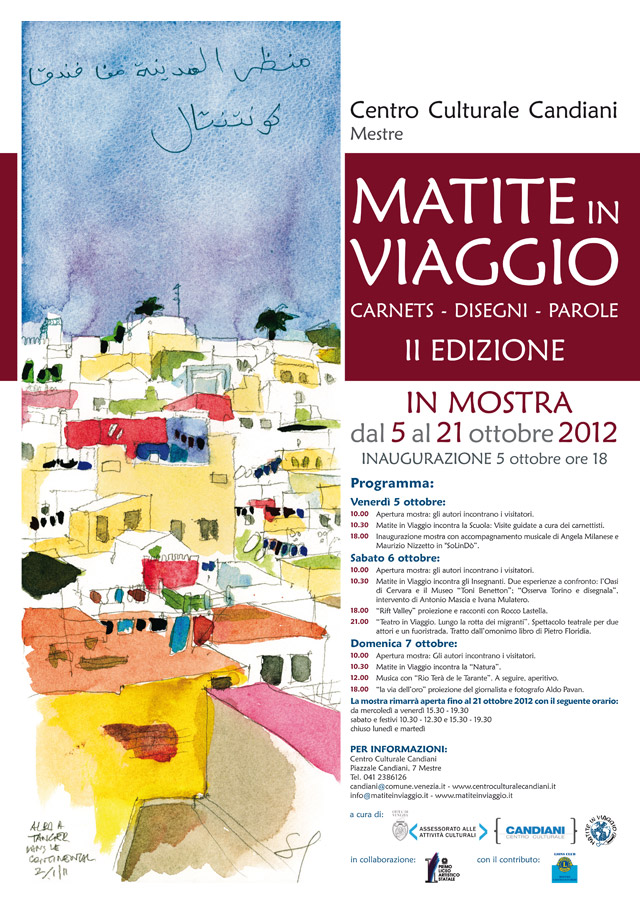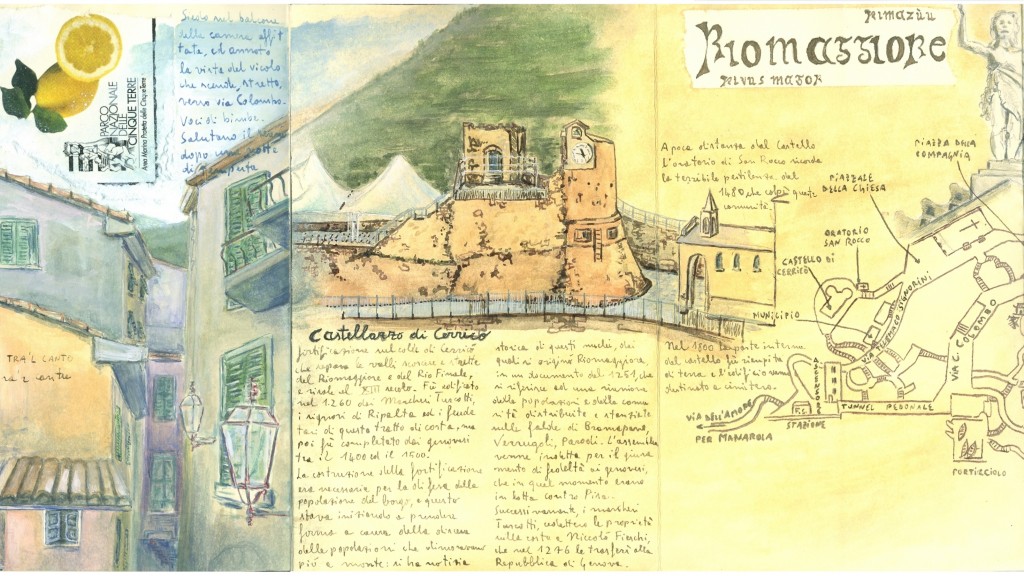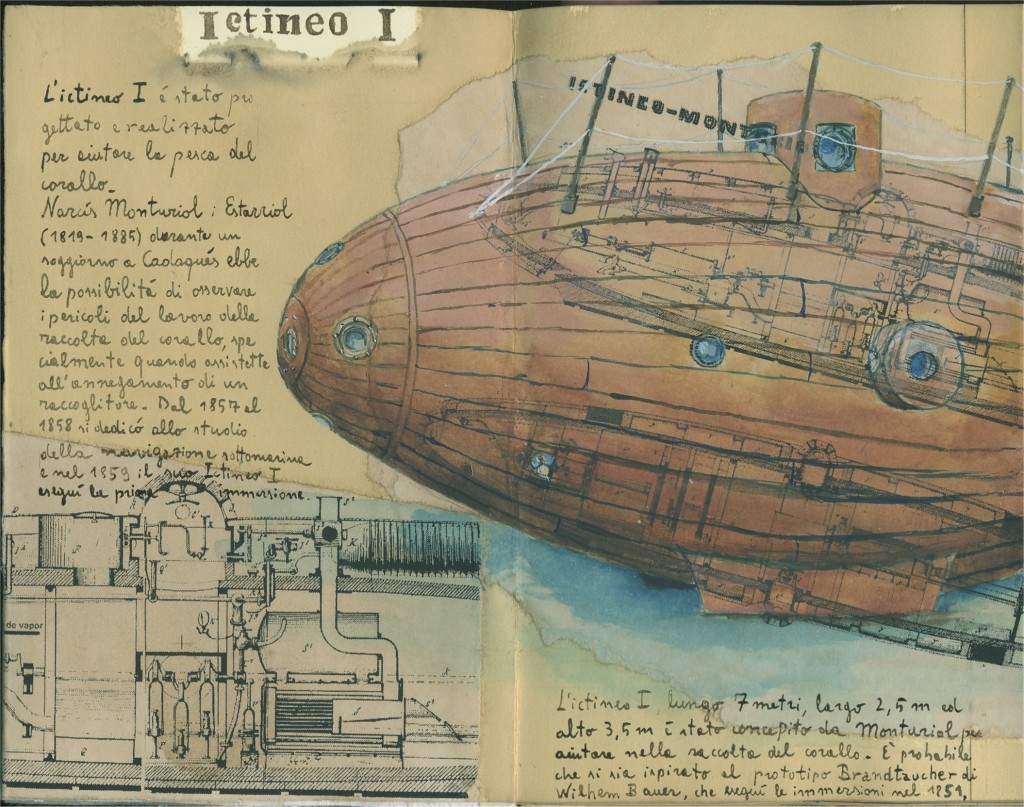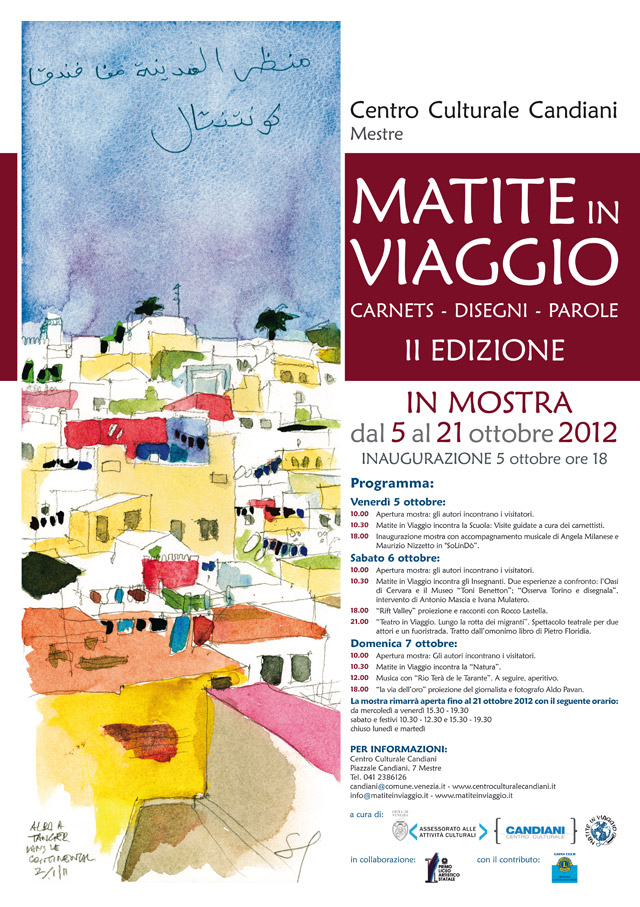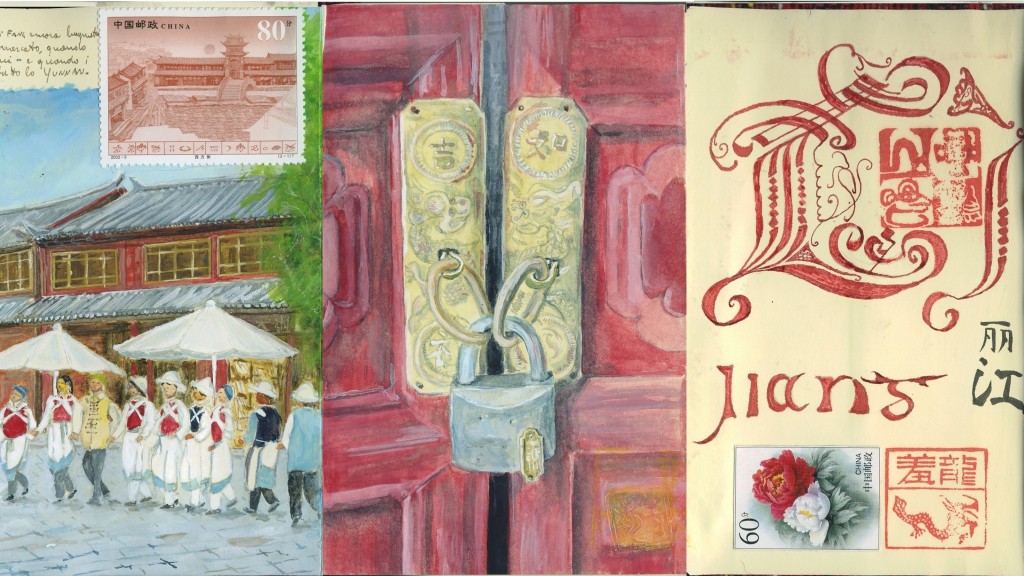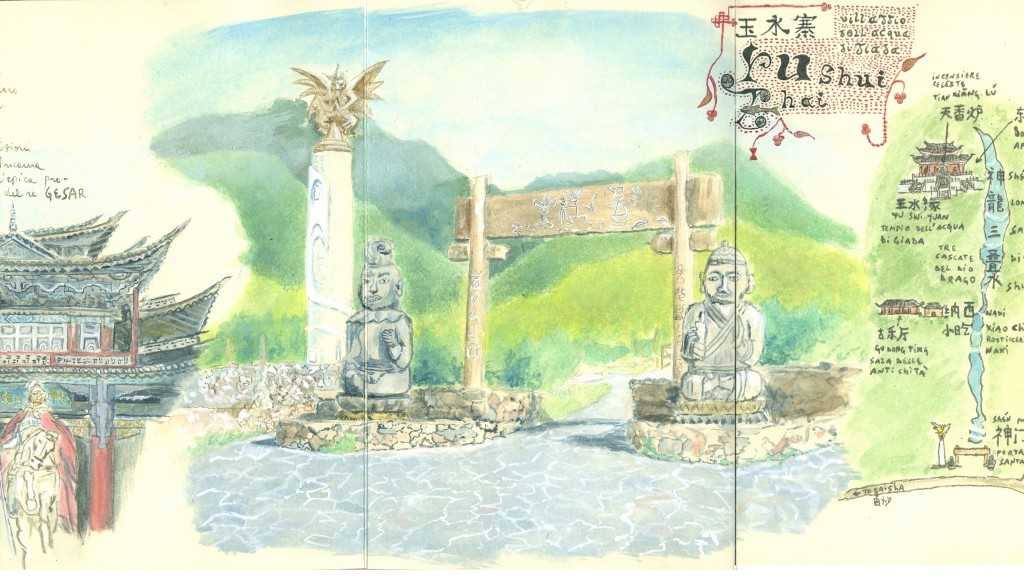Nine dragons gonna twist in Mestre – Matite in Viaggio 2012
 The Scroll of the Nine Dragons – Carnet d’etude
The Scroll of the Nine Dragons – Carnet d’etude
Last news I had from the friend Andrea Longhi was about my Carnet focused on the Scroll of the Nine Dragons, a Carnet of study consacrated to the masterpiece of 陈容 Chén Róng.
Here follow the presentation I’ve written for an eventual future edition of the Carnet.
The scroll of the nine dragons
The scroll of the nine dragons by 陈容 (traditional Chinese 陳容) Chén Róng (1210 – 1261) has to be considered as one of the most most important sample of Chinese scroll-painting and one of the masterpiece of Chinese art.
Since 1917 it is preserved at the Museum of Fine Arts, the scroll is perfectly preserved, and is painted ink on paper with some touches of deep-red pale ink.
The composition is completely overlooked by the glorious figures of the nine dragons, twisting and winding among clouds and waves. At the beginning of the scroll a dragon appears over a waterfall, a part of his body is hidden by smoky mist. The dragon size the hill by its sharp claws, facing ahead he seems chasing another dragon which it’s just throwing himself among clouds and mist, swiping the air with his tail.
The third dragon is depicted with his face in full view, is climbing over a hill.
Coming from left, the fourth dragon has just sized a pearl, is coming out from the water, provoking turbulent waves and twisting clouds.
Beside appear two other older dragons, one with horns extremely tined and the other with hoary head; they are chasing each other in a circle movement.
Most part of the seventh dragon’s body is dipped into the wiping waves.
Finally the eighth and nineth dragons appear facing each other. The former seems to leaping toward the latter two, while stepping his body on a rock-hill, while turning back the head looking for his encroacher.
Thanks to such balanced composition, the dynamic action of the dragons is taken to an end, as this masterpiece reach a pacific and quite resolution. The brushwork suggest to the viewer the idea of a dramatic beauty and a rhythmic movement on an universal scale.
Two inscriptions of the author and other sixteen calligraphies by an emperor, officials, scholars and Taoist priest are added to the panting, moreover there are many seal-stamps belonging both to the author of inscriptions and to collectors. In this copy such seals are replaced by the author’s seal-stamps, while the original are afterwards classified and studied.
Of the two inscriptions by Chen Rong, the shorter is a memorandum written at the beginning of the painting and chronologically after the scroll-painting was finished:
“The Picture of Nine Dragons was painted in the spring of Chia-ch’en (corresponding to the year 1244) . This scroll has come back into the possession of my son-in-law Hsien Li. Does not a divinely inspired thing surely find its allotted place? “
The longer inscription, in verses, is contemporary to the brushwork, and it’s made by some legends focused on dragons:
“ A real dragon stole a glance at the engraving at Ch’u;
In Chin-ling, two dragons flew away when the pupil of the eye was added.
When Chu-liang had already become an immortal, Chang followed him;
How ashamed was Liu Tung-weih when laughed at by the dragon couple!
The eight scrolls of Wu dragons were not worth hanging.
When drunk I spit the painting from within.
And the waves of Lung-men (the Dragon Gate) , or of San-hsiak (the Three Gorges) are like mountains,
Sending great roars from the depths into heaven.
The flying dragon appears from the gorge and flies toward the river of spring;
The force of Chiu-ho (the Nine Rivers) does not subdue him.
A dragon is like a Ch’ih-mum (Red-leaf) on the Tien-cheihn (Pond of Heaven) ;
The fungus aroused the land of mist and cloud.
Again, the goddess Ch’i-n has been punished by Chün-t’ien (the Lord of Heaven) ;
Lei-kung (the God of Thunder) struck mountains, and heaven and earth were black.
The glistening jade dragon rubbed scales against inaccessible cliffs;
(Dragon-like) big newt, he seems to avoid the visitor from Yang-ling.
The golden snake (lightning) flashed when the dragon awoke from his snoring;
His sharp-rising horns became Hai-men (the Gate of the Sea) .
His grinding teeth and sharp talons grasped the bright moon;
The dance of Tien-wu (the God of Sea) shook the base of heaven.
Over the thunderheads, the dragon taught his sons to make lightning;
The oldest dragon was in the fifth picture.
Two dragons relieved the people during the year of drought;
In the night the horse’s mane turned over the Tien-p’iao (the Ladle of Heaven) .
The warm waves of peach blossom time had reached the third level (of the Mount Kcun-lun) ;
Who dares to climb Yü-men, the most hazardous place?
Blue whiskers and deep red beards grew when fire was burning off their tails;
Thunder of the tenth month followed them as they fled upwards.
The Marquis of Shu slept peacefully in Nan-yang Wu-(hsiang) ;
All the figures were painted as strange and old.
They saved their superhuman strength waiting for the future;
In the world the people prayed for the heavy rain.
So-weng (Chén Róng) painted the picture of nine dragons.
His wonderful brushwork was unequalled in this world.
Looking from afar, cloud and water were like flying movement;
So that one feels it was done by the hand of a god.
Lung-kung from Hsüan-ch’eng had nine sons;
All of them entered the old man’s picture.
Who will paint two cows for me?
Do not put the golden bridle on one of them.
The colophon of the Picture of Nine Deer was written by Fu-weng; and the Picture of Nine Horses was praised by P’o-lao. Nevertheless, So-weng’s dragons are neither like deer nor horses. How could I dare to follow in the footsteps of Master Su and Master Huang ?
I simply put this down to record the year and the month.”
As according to Chinese custom about some addiction into original scroll-painting, an additional length of paper was inserted; it could be hypothesized that the painter, the owner or simply the critic evidently felt free about a certain freedom to the possibility of writing and signing by their seals-stamps directly on the painting or on any other part of the scroll.
Usually such addictions have some documentary value, as for instance they could be used to evince the relative merit, or even the authenticity of the masterpiece. The scroll is thus accompanied by six praises prayed by people of XIV century, mostly Taoist.
1. Written by Tung Ssŭ-hsüeh, contemporary to the artist. His original name was Tung Ssŭ kuo, from Chekiang province. After the destruction of Sung dynasty he converted and became Taoist monk. The eulogy was written in 1306:
“ In the year of hsin-yu (corresponding to the year 1261) , So-weng painted the Picture of a Pair of Swords for Han Hsinal of Tung shan at twilight, in the Garden of Nine
Streaked Pines; it was excellently done. In the tenth year of Ta Te (corresponding to the year 1306) I saw this scroll during a banquet at Yü-t’ien. Its brush work yields nothing
to the painting given to Han (Hsin). Written by the Mountain Man of Lao-chün, Tung Ssŭ-hsüeh.”
2. Composed by Chang Ssŭ-ch’eng, progeny of Chang Tao-ling (34 – 156 d. C.), author of painting of dragons and calligrapher, during XIV century he had become a chief Taoist priest. Eulogy is dated to 1331 year and is written in verse:
“ Hsüan-yün (Music) and Fo-mo (Painting) are called Tien-fen (the Winds of Heaven).
Thunderhead and lightning bolt drive away Lei-kung (the God of Thunder).
Yü-ssŭ (the Genius of the Rain) is busy;
Yüan-ch’i (Constitution of the Universe) is dripping.
Who would be the hero when the universe be comes transformed?
The strange lightning shines when two dragons exert their strength.
They are twisting and turning toward the west?out beyond the heavens.
Mountain rocks are destroyed when one of the dragons awakes.
The sound of his rubbing against rocks conceals the thunder.
One of the dragons does not struggle, but the others rush on.
They look for the Sui pearl and spring up on the bright moon.
The hoariest dragon is the one in the middle.
He enjoys himself leading his sons around in a circle.
One dragon comes out of the water showing his horns.
White waves, like mountains, reflect the sky.
One of the dragons flies up to the great emptiness.
Tien-p’iao (the Ladle of Heaven) has overturned to relieve the dried-up land.
The last dragon is at leisure,
Turning back his head as though he wished to return to dive into the deep sea.
Different styles have been shown by their gamboling and turning around.
Oh, he is not a dragon, how could he know the dragons so completely!
After (Liu) Tung-wei and (Chang) Seng yu had passed away,
The relations with the spirits of a thousand years have been continued by So-weng.
In appraising dragons one should not judge by details (scale and bristle).
The wonder should depend on the spirit.
The transmutations of Chiu-yang should be understood thoroughly.
How could people store them in a box?
I worry that thunder be followed by darkness.
One day they would disappear into the vast emptiness.
Written by Tien-shih (Grand Master) Tai yüan-tzŭ (the Elder Son of Heaven)
second year of Chih-Shun (corresponding to the year 1331), the first month of spring.”
3. Written by Wu Ch’üan-chieh (1269 – 13509, a powerful Taoist priest, active at the beginning of the XIV century; he was born in the district of An-jien, Jao-chou prefecture of the province of Kiangsi. The praise has not any date.
“Sky falling in thunder and rain;
Ink spilled like fire and lightning.
When the time came for untied clothes and (ink) to be spread far and wide,
The spirit had to listen to whatever he said.
Wind and cloud are made by falling snow;
In the twinkling of an eye, he flies away for a thousand Li
Ch’ien-yüan was assisted by Yung-chiu,
As the dragon studied with Lao-tzu.
Written by Hsien-hsien-tao-jen (Leisure Taoist) Wu Ch’üan-chieh.”
4. Composed by Ou-yang Yüan (1273 – 1357), Yüan dynasty scholar and official, active into the College of Han Lin, specialized in preparation of official state documents. He was dignified as Duke and canonized as Wen. His eulogy is in verse:
“Ch’ien, Yang and Liu-yao;
only Yang was solid;
The name, Six Dragons, resembled the dragon nature.
The connection between Ch’ien and Yung-chiu had been transformed by the god’s strength;
That is how in later years the Nine Dragons name appeared.
Ma-shih of Southern Lake followed this transformation;
His body, like a column, became tied by the eight dragons.
What grand and magnificent brushwork is here!
The Hall of Thunder and Wind are painted again.
(Signed) Ou-yang Yuan.”
5. Written by Chang Chu (1287 – 1368), scholar and official, author of the chronicles of Liao, Chin and Sung dynasties. As chin-shih into the Han Lin College he was holder of other high officials. As he achieved high distinctions by his poetry, he had written on this scroll a long poem in verse:
“ The Picture of Nine Dragons was shown to me by an immortal;
I understood that it belongs to the Lei-t’ien t’ang (the Hall of Thunder and Lightning) .
The Po-sang-chien paper is thirty ch’ih long;
Each dragon painted as strange and tortuous.
They turn about over gorges and broken cliffs;
The deep sea has been swallowed by the rest less waves.
They seize the Li pearl and struggle to reflect its splendor;
They stir up waterspouts when they weave in and out.
One flies to the moon (together) with his son,
With a hanging head returning to Pan-yu Cave.
Such grand brushwork, the transmutations endless;
Never before have the true bones (appearances) been realized.
Few people understand what I have seen in my lifetime;
I would not dare to be careless, because this painting is related to the spirit.
Ch’?n Jung knew how to control the dragon, even if he was not an immortal;
Who would be able to hide them in their baskets?
For the thunder would come through the walls
To tread with the bright sun and fly away with the wind.
When Kao Tang’s book was opened, hundreds of monsters escaped;
After looking carefully, mist and rain are felt.
Seng-yu did not like Tung Yü
In the late years no one could be compared with him.
At the beginning, he made rain to cover Chiu t’u
Oh, how grand a sense of duty he had!
This spirit is just what men should have in their work;
When (the dragon spirit) appears it sweeps away stupidity.
How can people constantly play with colors;
And waste away their energy painting grasses and insects?
Signed) Chin-ning (Yunnan province), Chang Chu.”
6. Written by Wang Po-i, born in Chiang-ning in the province of Kiangsu, active during the last part of the XIV century. Inscription was made at the end of 1380 year:
“ Originally the dragon was a spiritual thing,his body was pure Yang so his transmutations were limitless. The painter had to use the meaning of Ch’ien-yüan yung-chiu and the highest point of Yang to form a spiritual thing to frighten living beings. Because of the appearance and disappearance of his transformations, no one dared to steal a glance when the flying dragons were in the sky. What a
wonderful manner was used for these true spirits! That is out of the imagination. Don’t let them break through the wall and escape into the water; it does happen sometimes.
Po-i saw this scroll in the tenth moon of the year Keng-shen of Hung-Wu (corresponding to the year 1380). (Signed) Chiang-ning (Kiangsu province), Wang Po-i.”
Such six prayers, together with the two autograph calligraphy of the artist, also evince the conception of the Chinese dragon as a symbolic, glorious image, genius of force and a divinity. Moreover, in China, the dragon is a benevolent animal, not connected with bad or obscure powers. It is linked to fertility and rain, the genius of water, especially invoked during times of drought or flood. Moreover, because of its life-giving powers and benefits, it was directly linked to the good-administration activities, thus the figure of the dragon was directly elevated to symbolize imperial dignity.
Thought for our culture the dragon is considered as a purely emblematic manifestation as a product of fantasy, according to Chinese traditional culture it was absolutely considered as a real and natural being.
According to Erh-ya-yi, written by Lo Yüan (1136 – 1184), the dragon is the king of all the animals. He also quoted about Wang Fu description of the dragon as a being which have other nine animals semblances:
“the head like a camel (extended), horns like a deer (long), eyes like a hare (protruding), ears like a cow, neck like a snake, belly like a sea-serpent, scales like a carp, claws like a hawk, and feet like a tiger. It has eighty-one scales on its back, nine times nine, the largest positive (Yang) odd-numbered digit; it makes a noise like the rattle of a copper tray; it has a mustache and whiskers; it has a pearl under its chin; below the neck it has a reversed set of scales; on the head it has a protuberance called Po-shan or Ch’ih-mu; without this knob it cannot ascend the heavens. Its out-breathings form clouds which change into either water or fire.”
For many centuries, there have been reports and records which tell us that the dragon is a mythological animal, a symbolic figure and a metaphysical concept. In Chinese Art the dragon could be considered as one of the most important motif, a mystic, fantastic being, inspiration and cause of marvel and awe-fear, swift like the lighting and strong as the storm-wind. Appearing among clouds and mists, the dragon is visible just to the keen-eyed and enlightened minds opened to the widest spiritual forces of nature.
Along the top of the painting there are two inscriptions written by the Emperor Ch’ien Lung (1711 – 1799), the fourth emperor of the Ch’ing dynasty, and according to his words is possible to date the calligraphy to the year 1767:
“In the later spring of ting-hai, I, the emperor, ordered Chin T’ing-piao (ca. 1767, a court painter) to make a copy of this scroll. The spirit was more or less like the original. So I had to write at the beginning and at the end.”
Moreover, at the end of the brushwork, there are eight verses composed by an high official of the Ch’ien Long court, as he adapted in verse the inscription of his emperor, and he sealed his inscription by his seal-stamp at the end of the verses.
Yin Chi-shan (1697 – 1771) , a member of the Manchu Bordered Yellow Banner. He became a chin-shih in the year 1723 and was made a Grand Secretary in 1764. The emperor praised him not only as an able administrator but as one who was kind and broad-minded;
Liu T’ung-hsün (1700 – 1773), a native of Chu-ch’eng of Shantung province. He served twice as Chancellor of the Han Lin College and also served as Director General of both the State Historiographer’s Office and the commission to compile the catalog of the Imperial Library;
Yü Ming-chung (1714 – 1780), native of Chin-t’an in the province of Kiangsu. When he was twenty-four, he became a chin-shih with highest honors, and was made a first class compiler of the Han Lin College. He was constantly with the emperor on tour or in the capital, and many important policies of the middle Ch’ien Lung period were decided by the emperor in accordance with his advice;
Tung Pang-ta 1699 – 1769), a native of Fu-yang in the province of Chekiang. In 1747 he was appointed sub-chancellor to the Grand Secretary and later, among other positions, he was made the President of the Board of Ceremonies. As a painter he won high recognition;
Ch’iu Yüeh-hsiu (1712 – 1773), native of Hsin-chien in the province of Kiangsi. He became a chin-shih in 1739. His principal activity was the superintending of flood control in eastern Honan, western Shantung and northern Anhwei provinces;
Wang Chi-hua (1720 – 1776), a native of Ch’ien-t’ang, province of Chekiang. He became chin-shih in 1745 and later was made a Minister of Revenue, and a Chief Director General of both the State Historiographer’s Office and of
the commission to compile the catalog of the Imperial Library;
Ch’ien Wei Ch’eng (1720 – 1772), a native of Wu-chin of the province of Kiangsu. He became Chin-shih in 1745 with highest honors and then was appointed a Han Lin compiler of the first class. He was a master both of calligraphy and
painting;
Ch’en Hsiao-yung (1715 – 1779), notable critic and calligrapher. He served at Ch’ien Lung’s court and participated in the compilation of the Hsi-ch’ing ku-chien an illustrated and annotated catalog of 1,529 bronze utensils, and other objects of antiquity, preserved in the
Imperial Palaces.
We have very few information about the life of Cheng Rong. He’s registered in the work compiled in 1580 by Hsü P’u entitled “ Min-hua-chi” as disciple of Kung-ch’u Master, born in Ch’ang-lo (today Min-hou district, province of Fukien). He had passed the chin-shih exam in the second year of Tuan P’ing ( 1235 ), thus he entered in the government with a rule into the Department of Education; later he became Prefect of the district of P’u-tian in the province of Fukien. He gained a very high individual reputation for his integrity and for his abilities as scholar and painter, specialized in paintings of dragons.
His brush-works dedicated to dragons seems to represent the transformation of their spirits. He painted clouds among which the dragons flying adopting the so-called spilled ink
style and splashed ink over the area of mist and breaking waves apparently by snapping the brush so that ink-spots scattered on the paper. When he was drunk, he shouted aloud, took off his cap, dipped it into ink and then aimlessly smeared and rubbed with it, making a rough picture which he afterwards completed with the brush. Sometimes the whole figure of the dragon was shown, sometimes only a leg or a head. The dimly defined shapes were beyond description, almost inconceivable, yet truly divine and mysterious.
When he painted pine and bamboo, he adapted Liu Ch’eng-hsüan’s (Liu Kung-ch’üan, 778 – 865, an official and calligrapher of the Tang dynasty) Iron Hook Manner (brush-strokes like iron hooks). His paintings were regarded as masterpieces in the days of the reign dated Pao Yu (1253 – 1258). Toward old age, his brush manner became more and more simplified, concentrated and wonderful. His paintings which have touches of deep red color are comparable to Tung Yü’s work.
Moreover we know that Chén Róng’s famed dragon paintings were regarded as masterpieces even in his own day. We also know that his technique in the art of painting is somehow different from most of his contemporaries. If we examine this scroll carefully, we will be able to find some traces made by the impression of cloth appearing throughout the picture (mostly along the edge of the dragon figures and the clouds).
Evidently, Chén Róng used cloth as one of his instruments for pictorial representation. When he painted he made a rough sketch with some kind of cloth, or even with his own cap. Then he completed the picture with brush and dark ink
in strongly defined wrinkles for figures, clouds, water and rocks, which gives the picture its distinctive quality, modeling and texture.
The picture also shows that the master’s brush-work has a combination of rhythmic beauty and powerful strength. The motifs which appear in his picture, such as dragons, rocks, and waves, suggest a sense of life-motion.
The style-analysis of the artist’s brush-strokes evinces different type and techniques: among rocks and cliffs, the Small-axe Wrinkles or Hsiao-fu-p’i ts’un have been employed by the artist. The effect of these strokes is of faulted angular rocks. This type of ragged stroke is only produced when the brush is dragged sideways. On the chins of these dragons is found a type of sharp-headed dot or short-pointed strokes that we may call Sharp-headed Dots or Chien-fou tien also Nail Wrinkles or Ting ts’un, which are made by the tip of the brush. They can be produced by a broken or old, worn brush. The effect suggests an irregular texture suitable for the appearance of a dragon.
Among the figures also appears brushstrokes made by the dragging of an oblique-hold brush-tip, while the exit of the brushstroke is made by the side of the brush, a style named Che-tai ts’un, as especially refined and delicate are the brushstrokes which depicted the head of the hoary-dragon, within is clear the sense of variation and continuity of the movement.
The same style is adopted also in painting vortexes and waves, produced by the movement of the dragons; here ink is directly sprinkled on paper, expressing the foam of the wiping-out waves, phase of painting executed at the end of the brush-work.
According to Chen Rong words, this painting was in the hands of his son-in-law Hsien Li; unfortunately we know nothing about this possessor. According to Hsien-chi Tseng (1957) it could be supposed that, for some reason this painting passed into the possession of Taoist priests during the fourteenth century. For the names connected with the painting during this period are all, not unknown, Taoist figures. During the seventeenth
century, it became the possession of Keng Chao-chung (1644-1686), a member of the Chinese Plain Yellow Banner, who married a daughter of the prince of the imperial family of the Ch’ing dynasty. He was a notable collector of the early Ch’ing era. During the second-half of the eighteenth century, this painting was presented to the Emperor Ch’ien Lung, and he passed it on to his son Yung-yen (1760-1820), who became the fifth emperor of the Ch’ing dynasty in the year 1796, under the reign-title Chia Cheing. Before the scroll came into the possession of the Museum, it was in the collection of I-hsin (1833-1895), the first prince Kung, who was the sixth son of the Emperor Hsiian Tsung (1782-1850).
Below are studied and listed the original seals, as appearing in the following plate and according to their chronological order. The seals of the author of the copy is finally listed in the order they appear both in his painting and in the dedicated plate.
Original seal-stamps
 Original Seal-stamps – 1
Original Seal-stamps – 1
A. Chén Róng
1. So-weng: one of the given name of Chen Rong
B. Chang Ssu-ch’eng
2. San-shih-chiu-tai t’ien-shih: 39° generation of the Great Master
3. T’ai-hsüan-tzŭ: the elder son of the heaven.
C. Wu Ch’üan-chieh
4. Ch’üan-chieh
5. Chih-shih-yen: the words for a peaceful era.
6. Ho-hsi wu-tzŭ: one of the given name of Wu Ch’üan-chieh
7. Jao-kuo-shih-chia: an old and honorable family of Jiao-kuo.
D. Ou-yang Yüan
8. Kuei-chai shu-yin: one of the given name of Ou-yang Yüan
E. Chang Chu
9. T’ing-feng-yü chai: a Studio for Listening to wind and rain
10. Hsian-ling chang-shih: Chang family of Hsian-ling
F. Wang Po-i
11. Po-i
12. Ch’ien-ch’ing k’an-k’un wu-li: one of the seal of Wang Po-i
G. Keng Chao-chung
13. Tu-wei keng-hsin-kung shu-hua chih chang: seal for calligraphies and paintings of Tu-wei Keng Hsin-kung’s possession. Tu-wei is a title of sixth and seventh orders of nobility of the Ch’ing era. Keng Chao-chung, a notable collector and official of the early Ch’ing dynasty.
14. Hsin-kung chen-pi: very valuable article of Hsin-kung. Hsin-kung is one of Keng Chao-chung’s names.
15. P’o-hai-chu-jen chen-ts’ang (repeated 4 times): a precious possession of Master P’o-hai. P’o-hai is one of the name of Chao-chung.
E. Emperor Ch’ien Lung
16. Ch’ien-lung yü-lan chih-pao: a precious thing for His Majesty Ch’ien Lung’s inscription.
The seal often appears among paintings and specimens of calligraphy of the Imperial collection..
17. Wu-fu wu-tai t’ang ku-hsi t’ien-tzŭ pao: an emperor is seldom like antiquity and has a hall of five blessings and five generations.
18. T’ai-shang huang-ti chih-pao: a precious thing of the Super Emperor.
19. San-hsi-t’ang ching-chien hsi: an Imperial signet of essential inspection at the Hall of Three Rarities.
20. Shih-ch’ü pao-chi: a treasury book case of the Library of Stony Gutter. The name of one of two well-known catalogs of paintings and calligraphies which were preserved in the various halls of the Emperor Ch’ien Lung’s palace. The catalog, a work of 44 chüan, was commissioned in 1744, completed in 1745, and first printed in 1918.
21. Pa-cheng-mao-nien chih-pao: precious thing of an old man who has eight evidences to remember.” Pa-cheng or Eight Evidences are Ku (reason) ; Wei (to be) ; Te (to obtain) ; Sang (to lose) ; Ai (to pity) ; Lo (joy) ; Sheng (living) ; Szu (death). The term is originally from Lieh-tzu, Chou-mu wang. The seal was made between the years 1796 and 1799.
22. I-tzu-sun: it is right that my posterity.
23. Ku-hsi t’ien-tzŭ: an emperor whose like was seldom seen since antiquity.
24. Shih-ch’ü chi-chien: second inspection by the Library of Stony Gutter. After Shih-chü pao-chi, two supplementary catalogs were written. The first supplement is entitled Shih-ch’ü pao-chi, a work of 88 chüan ordered to be compiled in 1793, but never published. The second supplement (san-pien) of 108 chüan in 1817 also has never been published.
25. Ch’ien-lung chien sang: enjoyed and appreciated by Ch’ien Lung.
26. Yü-shu-fang chien-ts’ang pao: an inspected and possessed precious thing of the Imperial library.
27. Ch’ien: Heaven. The first character of Diagrams (bagua), means, Heaven; a circle; a ruler; a father; jade, etc., also it represents what is great and originating, penetrating, advantageous, correct and firm. The first character of Hung li’s (the emperor) reign-title.
28. Lung: The character represents prosperous, generous and magnify. The second character of Hung-li’s (the emperor) reign-title.
I. Emperor Chia Ch’ing
29. Chia-ch’ing yü-lan chih-pao: a precious thing for His Majesty Chia Ch’ing’s inspection.
J. Yin Chi-shan
30. Yung-ko Sheng-shih: singing songs for the prosperous era.
31. Ch’en yin chi-shan: Your servant, Yin Chi-shan. The seal used only for addressing the throne.
K. Liu T’ung-hsün
32. Hsün: the second character of Liu T’ung-hsün’s given name.
33. T’ung: the first character of Liu T’ung-hsün’s family name.
L. Yü Ming-chung
34. Ch’en yü ming-chung: your servant, Yü Min-chung. The seal used only for addressing the throne.
35. Hua-hsuen kuei-hsin
M. Tung Pang-ta
36. Ch’en Pang-ta yin: Your servant, seal [of ] Pang-ta. The seal used only for addressing the throne.
37. Jan-han: Imbued with brush-tip
N. Ch’iu Yüeh-hsiu
38. Ch’en ch’iu yüeh-hsiu: You servant Ch’iu Yüeh-hsiu. Used for addressing the throne.
39. Ching-shu: inscribed with respect.
O. Wang Chi-hua
40. Ch’en: your servant. Formerly used by civil officials of themselves at the beginning of their given names when addressing the throne.
41. Chi-hua: the name of Wang Chi-hua.
P. Ch’ien Wei-ch’eng
42. Ch’en ch’ien-wei-ch’eng: Your servant, Ch’ien Wei-ch’eng. Used for addressing the throne.
43. Jan-han
Q. Ch’en Hsiao-yung
44. Ch’en Hsiao-yung: Your servant Hsiao-yung
45. Ching-shu: inscribed with respect.
R. I-shin, the Prince Kung
46. Kung ch’ing-wang chang: seal of the first prince Kung.
Author’s seal-stamps
S. Xiu Long, author’s Chinese name
47. Xiu Long: the name written in Jiaguwen, engraved by Nicola Picchioli, November of 2006
48. Xiu Long: the Chinese name of the author written in Bronze ideograms, engraved by Nicola Picchioli, November of 2006
49. Xiu Long: the name in traditional regular ideograms, engraved in Lijiang by unknown artisan, August of 2009
50. Xiu Long: the name, written in Hanyin style, engraved in Shanghai by unknown artisan, July of 2009. The decoration I’ve taken from an imperial seal-stamps watched in Shanghai Art Muesum.


